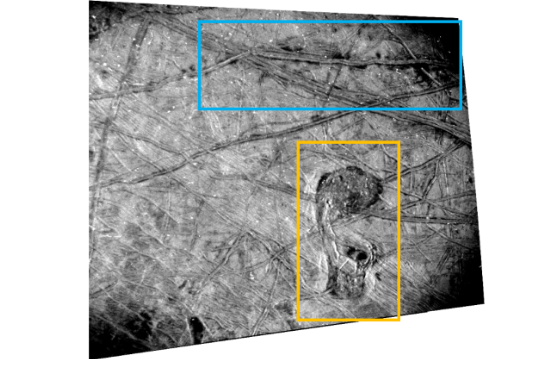Landmarks on the surface of Europa indicate that the ice crust is under the control of the waters below. Most importantly, Juno’s recent visit revealed what could be plume activity that, if real, would allow future missions to sample the interior ocean without the need to land.
It’s been nearly two years since Juno made its closest approach to Europa, but its observations are still being analyzed. Remarkably, although Juno has been orbiting Jupiter since 2016, the five images taken by Juno on September 29, 2022 are the first close-ups of Europa since the last visit by the Galileo spacecraft in 2000.
This may represent a shocking disregard for one of the most intriguing worlds in the solar system, but it could also provide a long baseline to see what has changed.
Europa is the smoothest object in the Solar System, thanks to the constant buoyancy caused by the internal ocean. Still, it’s far from impersonal, and Juno has spotted some steep-walled depressions 20 to 50 kilometers (12 to 31 miles) wide and fault patterns believed to indicate “true polar wander.”
“A true polar wander occurs when Europa’s icy shell detaches from its rocky interior, causing high levels of stress on the shell, leading to predictable fracture patterns,” Dr. Candy Hansen of the Planetary Science Institute said in a statement.
The idea behind a true polar wander is that the shell that sits on top of Europa’s internal ocean rotates at a different rate than the rest of the Moon. It is believed that the water below moves and drags the shell with it, and currents in the ocean affect the movement of the shell. The currents, in turn, are thought to be caused by heating in Europa’s rocky core as the gravitational pull of Jupiter and its large moons turns Europa into a giant ball of tension.
In the process, interactions between the ocean and the ice can stretch and compress regions, creating the cracks and ridges observed after Voyager 2’s visit.
Hansen is part of a team examining Juno’s images of Europa’s southern hemisphere. “This is the first time these fault patterns have been mapped in the Southern Hemisphere, suggesting that the true impact of the polar wander on Europa’s surface geology is more extensive than previously recognized,” the scientist said.
Not all changes on the maps of Europe are the result of internal ocean currents. Even NASA seems to succumb to optical illusions. “Gwern Crater is gone,” Hansen said. “What was once thought to be a 13-mile-wide Guern impact crater—one of the few documented impact craters in Europe—was revealed in JunoCam data as a set of intersecting ridges that produced an oval shadow.”
However, Juno gives more than it takes away. The team is excited that they call the Platypus for its shape, not because it has a bunch of features that shouldn’t go together. Fungal formations at its edge appear to be collapsing into it, a process the team believes may be caused by pockets of salt water that have partially seeped through the ice sheet.

The object, named by planetary scientists who apparently have never seen a real platypus, is outlined in yellow with the ridge area in blue.
Image credit: NASA/JPL-Caltech/SwRI
Such pockets would be fascinating indirect targets for the Europa Clipper to study, but even more interesting are the dark spots that may have resulted from cryovolcanic activity.
“These features hint at present-day surface activity and the presence of subsurface liquid water on Europa,” said Heidi Becker of the Jet Propulsion Laboratory. Such activity has been confirmed in the geysers of Enceladus, but there is conflicting evidence as to whether it is currently occurring on Europa.
Such an activity would make it possible to probe for signs of life in the interior ocean simply by flying through the plume and collecting ice flakes, without the need to land, let alone drill.
Currently, the polar wander can cause fairly modest adjustments to the location of features on Europa’s surface, but there is evidence that millions of years ago, for unknown reasons, a shift of more than 70 degrees occurred.